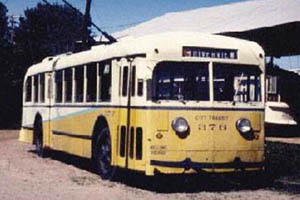
- Builder
- Pullman-Standard Car Co.
- Description
- Model 45WS-102-450S
- Secondary Use
- None
- Type
- Trackless Trolleys
- Year
- 1942
- Retired from Service
- 1969
- Acquired by the Museum
- 1969
- Note
- No. 376 is stored in Central car barn.
City Transit Company 376
From Dayton, Ohio
History
Dayton, OH was served by five street railway companies: Dayton Street Railway, Dayton and Xenia Street Railway, Oakwood Street Railway, Peoples Street Railway and City Railway Company. The first use of trolley buses in Dayton was in 1933. Dayton Street Railway suffered a major car barn fire in August 1932 and decided to use the opportunity to convert its single route to Brill trolley buses. The other companies followed, creating the unusual situation of five different companies all operating trolley buses in the same city. By 1947, all five companies fully converted to trolley buses, except for a few motor bus feeder lines.
In 1944, Dayton’s City Railway Co. acquired eight trolley buses from Pullman-Standard, numbered, by tens, 306 – 376. During World War II, the Office of Defense Transportation (ODT) designated Pullman-Standard as the only manufacturing company permitted to build trolley buses. During the war, Pullman-Standard built coaches similar to the 300s for various cities in the U.S. and Canada, including Boston. Pullman-Standard’s trolley bus production spanned from 1932 to 1951 and totaled 1,863 vehicles, the largest of any North American manufacturer.
Dayton’s five transit operators went through a series of mergers, eventually fully consolidating into City Transit Company in 1956. Dayton and Xenia consolidated in 1955 and the Oakwood Street Railway in 1956. The city of Dayton wished a complete transit consolidation and held up a requested fare increase until this was done. There were strong local feelings of affection for the D&X and Oakwood operations. Accordingly, the red or maroon strip on trolley bus sides memorialized Oakwood, and the robin’s egg blue strip memorialized the D&X. No. 376 displays the robin’s egg blue D&X stripes. City Transit President W.W. Owen continued to favor trolley buses. In the 1960s, he had the 300s rebuilt and maintained in base service, but these coaches were retired by 1969. Today, the Greater Dayton Regional Transit Authority supplements its motor bus operation with a fleet of 26 Gillig Bus Rapid Transit type trolley buses, making it one of only five U.S. cities still using trolley buses.
Seashore acquired No. 376 in 1969. No. 376 was the first and oldest Dayton trolley bus to be preserved at a museum. In the 1970s, Seashore repaired the area around the base of No. 376’s trolley poles and repainted the coach.
Technical Information
- Seats: 44
- Control: MRC
- Brakes: Straight Air
- Compressor: DH-10
- Tires: 11x22
Motor
- Number: 1
- Manufacturer: General Electric
- Model: 1213
Weight and Dimensions
- Length: 37’ 4.00"
- Width: 8’ 5.00"
- Height: 10’ 9.00"
- Weight: 22000 lbs.
© 1998 - 2025 New England Electric Railway Historical Society. All Rights Reserved.